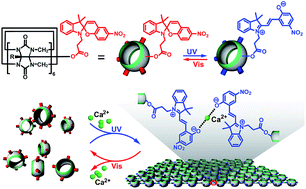Light-mediated formation and dissociation of a two-dimensional supramolecular polymer sheet: one step closer to sustainability†
Abstract
Recently, a few strategies have emerged to synthesize two-dimensional (2D) polymers comprising laterally connected areal monomeric units that extend in two orthogonal directions. Despite such progress, rational design of non-persistent 2D polymers that require neither harsh conditions nor extra chemicals to dissociate, thus imposing a potentially diminished environmental burden, remains a challenge. Here, we report a mechanically new strategy that enables formation and dissociation of a 2D supramolecular polymer sheet in response to light. The constituent monomers are cucurbit[6]urilSP, an engineered cavitand bearing multiple photochromic spiropyran (SP) moieties at its periphery. When irradiated with UV light, the SP isomerizes into zwitterionic merocyanine (MC), affording a single-cucurbit[6]uril-thick polymer sheet in the presence of Ca2+via multiple in-plane inter-monomeric MC⋯Ca2+⋯MC bridges. The free-standing polymer is stable in the dark, but dissociates into oligomers upon exposure to visible light as the peripheral MC isomerizes back to SP. Since light is a noninvasive and environmentally benign stimulus with high spatiotemporal solution, the rationale underlying the present effort may point the way towards new 2D polymers that are non-persistent to avoid repeating the accumulation problem now haunting conventional linear polymers, thus bringing this emerging material one step closer to sustainability.



 Please wait while we load your content...
Please wait while we load your content...